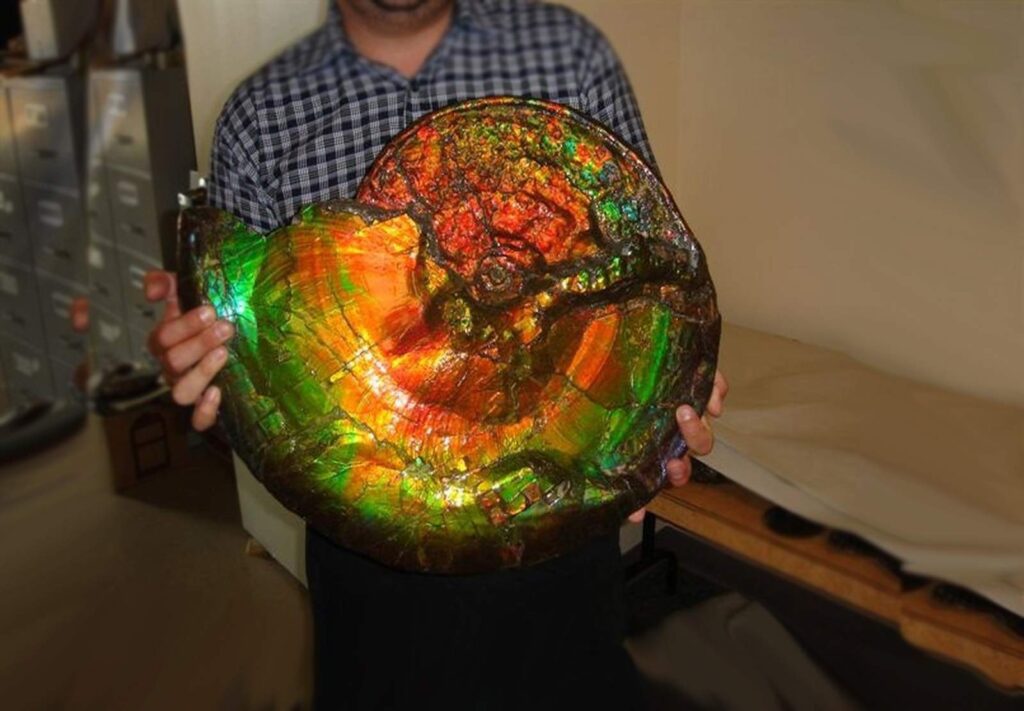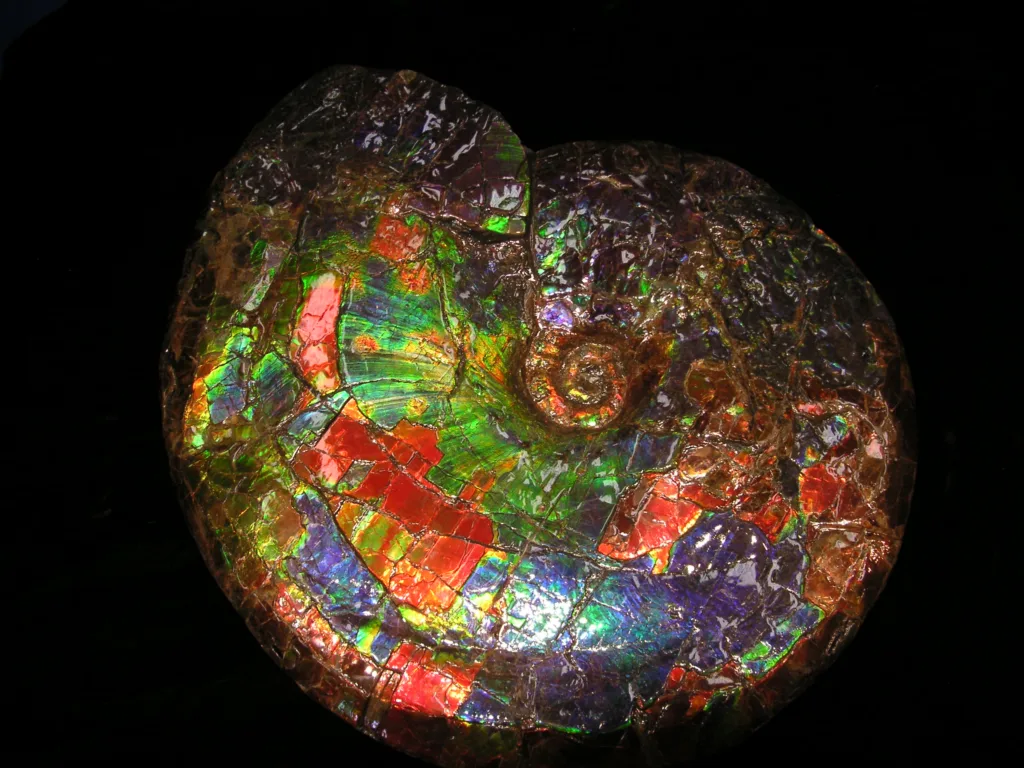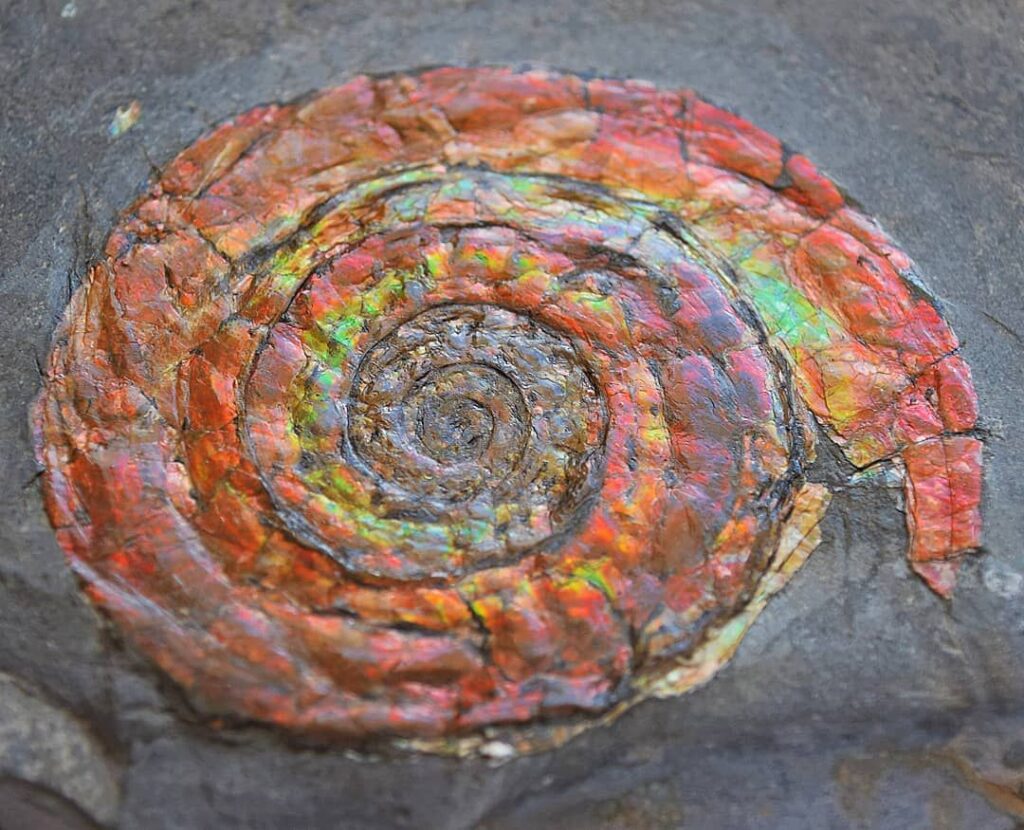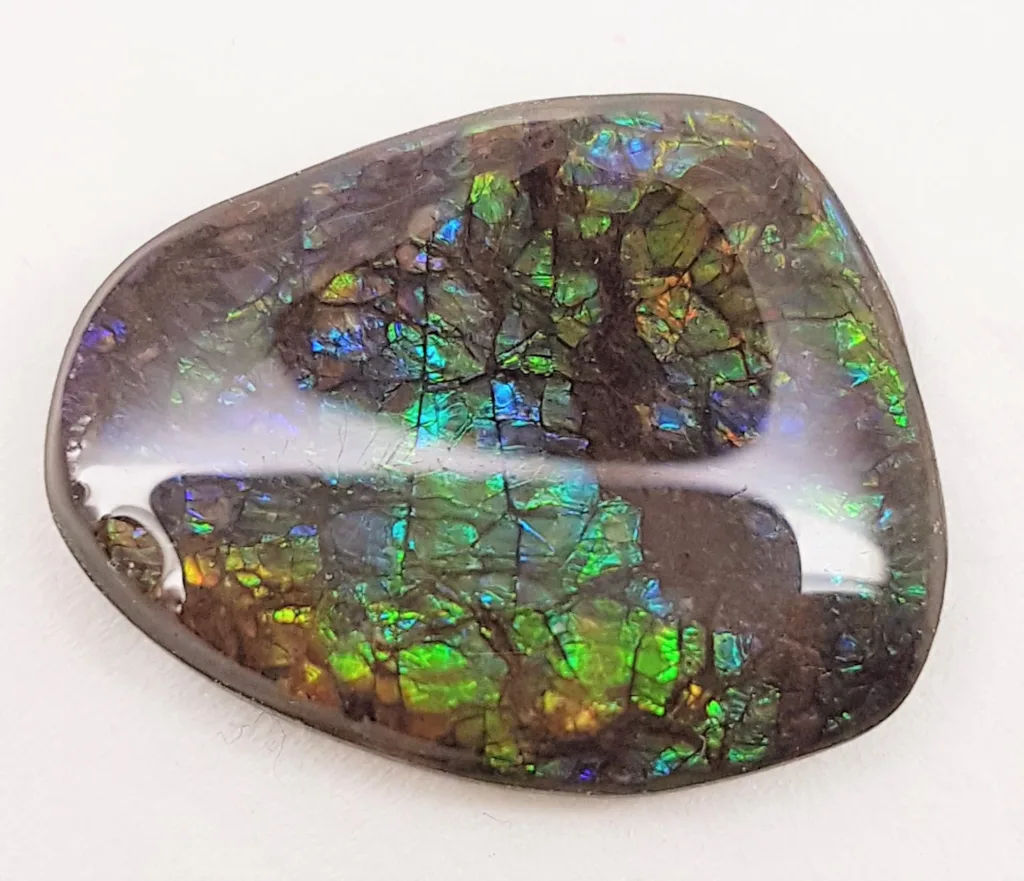Ammolite is a strikingly beautiful and rare gemstone with a rich history tied to the ancient marine world. Its vibrant, iridescent colors make it one of the most visually captivating gems on Earth. Unlike traditional gemstones such as diamonds or sapphires, Ammolite has an organic origin, much like pearls and amber, as it is formed from the fossilized shells of extinct marine creatures called ammonites. These creatures roamed the oceans millions of years ago, and over time, their remains transformed into Ammolite through a unique geological process. Today, Ammolite is highly valued both for its rarity and for its wide array of brilliant colors.

The Discovery of Ammolite
Although ammonite fossils have been known and used by indigenous cultures for thousands of years, Ammolite as a gemstone was only officially recognized relatively recently. The Blackfoot tribe of North America, who inhabited the regions where Ammolite is found, referred to these ammonite fossils as “buffalo stones” or “Iniskim” and believed they held mystical powers. They used them in rituals and as symbols of luck and protection, associating them with the abundance of the buffalo, a critical resource for their survival.
However, the scientific recognition of Ammolite as a gemstone came in 1981, when the World Jewellery Confederation (CIBJO) granted it official gemstone status. Since then, it has been used in fine jewelry, and its popularity has grown internationally due to its extraordinary appearance.

Origins and Formation of Ammolite
The origins of Ammolite date back to the Late Cretaceous period, around 70 to 75 million years ago. During this time, large marine reptiles called ammonites thrived in the ancient inland seas that covered much of what is now North America. Ammonites are extinct relatives of modern-day cephalopods, like squid and octopuses, and had coiled, spiraled shells that served as both protection and buoyancy devices in the ocean.
When the ammonites died, their shells sank to the seafloor, where they became buried by layers of sediment. Over millions of years, these shells underwent a unique process of fossilization, as the surrounding sediments compressed them. During this time, the aragonite that made up the shells was preserved, and under the right conditions, the material developed the iridescence and color play that make Ammolite so distinctive.
The key geological formation responsible for Ammolite is the Bearpaw Formation, located primarily in southern Alberta, Canada. This formation is a rich deposit of ammonite fossils, and it is the only significant commercial source of Ammolite in the world. The exact combination of minerals, pressure, and time required to produce Ammolite is very rare, which is why it is found in such a limited area. It is also why Ammolite is considered one of the rarest gemstones on Earth.
Properties of Ammolite
Ammolite’s beauty lies in its incredible spectrum of colors and the way it interacts with light. However, the stone’s appeal extends beyond just its appearance. Here are some of its most notable properties:

1. Color and Iridescence
The most striking feature of Ammolite is its range of vibrant colors. The gemstone’s iridescence is caused by the microscopic structure of its aragonite layers, which diffract light in complex ways. This optical phenomenon, known as interference, causes different wavelengths of light to reflect back to the observer in a variety of colors. The colors seen in Ammolite can include shades of red, orange, green, blue, purple, and even rare flashes of gold or violet. The intensity and range of these colors depend on the thickness and orientation of the aragonite layers.
Higher-quality specimens of Ammolite display a full spectrum of colors, with the most valuable pieces showing a balanced, vivid array of red, green, and blue hues. Stones that exhibit strong color change when viewed from different angles are particularly prized in the gemstone market.
2. Organic Composition
Ammolite is classified as an organic gemstone because it originates from the biological material of ammonite shells, specifically their layers of aragonite. This sets it apart from most gemstones, which are formed from inorganic minerals. Ammolite’s organic origin places it in the same category as pearls, coral, and amber. However, this organic composition also makes Ammolite more fragile than traditional gemstones.

3. Hardness and Durability
Ammolite is relatively soft compared to other gemstones, with a hardness rating of 3.5 to 4 on the Mohs scale. This means that it can be scratched by harder substances and is more prone to damage if not carefully handled. For this reason, Ammolite used in jewelry is often treated with a protective coating, typically resin or quartz, to enhance its durability. Additionally, it is frequently fashioned into doublets or triplets—laminated layers of Ammolite and other materials (such as a backing layer and a transparent protective top layer)—to increase its strength and usability in jewelry designs.
4. Unique Patterns and Texture
Besides its color, Ammolite is also appreciated for its unique surface patterns. Some specimens feature a mosaic-like texture with a cracked or “dragonskin” appearance, which is highly sought after by collectors and designers alike. These patterns form naturally over time as the fossilized shell undergoes slight changes due to geological pressure and environmental factors.
Cultural Significance and Symbolism
For thousands of years, Ammolite has held spiritual and cultural significance for indigenous peoples, particularly the Blackfoot tribe of North America. They regarded it as a sacred stone with the power to bring good fortune, protect the wearer from harm, and provide health and prosperity. They believed that Ammolite, or buffalo stone, could summon buffalo herds to ensure the tribe’s survival through harsh winters.
In modern times, Ammolite has become associated with feng shui practices. Believers in feng shui view Ammolite as an energy stone that can bring balance, prosperity, and wisdom to the owner. Because of its spectrum of colors, it is believed to contain the energies of multiple elements, including fire, earth, wood, and water. As a result, it is often used as a talisman or placed in homes to promote harmony and well-being.
Uses of Ammolite

Ammolite’s rarity and striking beauty have made it a popular choice for fine jewelry. It is often crafted into pendants, earrings, rings, and other pieces, typically set in gold or silver to complement its vibrant colors. Because of its relative softness, Ammolite jewelry is typically reserved for special occasions rather than everyday wear. High-quality Ammolite can command high prices due to its rarity and the difficulty in finding stones with strong, vibrant colors.
Aside from jewelry, Ammolite is also used in decorative arts and as a collector’s item. Large, well-preserved ammonite fossils with intact Ammolite layers are highly sought after by fossil collectors and are often displayed as natural works of art. In some cases, entire ammonite fossils are polished to reveal the Ammolite within, creating stunning showpieces.
Conclusion
Ammolite is a gemstone like no other, born from the remnants of ancient marine life and transformed over millions of years into a dazzling array of colors. Its rarity, organic composition, and cultural significance make it one of the most unique and fascinating gemstones in the world. From the ancient beliefs of indigenous peoples to its modern-day use in feng shui and fine jewelry, Ammolite continues to captivate and inspire those who encounter it. Its legacy as both a symbol of nature’s beauty and a precious gem ensures that Ammolite will remain a prized treasure for generations to come.




































